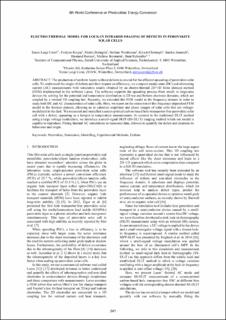Please use this identifier to cite or link to this item:
https://doi.org/10.21256/zhaw-26409Full metadata record
| DC Field | Value | Language |
|---|---|---|
| dc.contributor.author | Comi, Ennio | - |
| dc.contributor.author | Knapp, Evelyne | - |
| dc.contributor.author | Battaglia, Mattia | - |
| dc.contributor.author | Kirsch, Christoph | - |
| dc.contributor.author | Weidmann, Stefano | - |
| dc.contributor.author | Jenatsch, Sandra | - |
| dc.contributor.author | Hiestand, Roman | - |
| dc.contributor.author | Bonmarin, Mathias | - |
| dc.contributor.author | Ruhstaller, Beat | - |
| dc.date.accessioned | 2022-12-16T13:08:09Z | - |
| dc.date.available | 2022-12-16T13:08:09Z | - |
| dc.date.issued | 2022-12-09 | - |
| dc.identifier.isbn | 3-936338-86-8 | de_CH |
| dc.identifier.uri | https://digitalcollection.zhaw.ch/handle/11475/26409 | - |
| dc.description.abstract | The production of uniform layers without defects is crucial for the efficient upscaling of perovskite solar cells. To understand the origin of defects and their impact on efficiency, we compare steady-state (DC) and alternating current (AC) measurements with simulation results obtained by an electro-thermal 2D+1D finite element method (FEM) implemented in the software Laoss. The software supports the upscaling process from small- to large-area devices by solving for the potential and temperature distribution in 2D top and bottom electrode domains, which are coupled by a vertical 1D coupling law. Recently, we extended this FEM model to the frequency domain in order to study both DC and AC characteristics of solar cells. Here, we report on the extension of this frequency-dependent FEM model to the thermal domain, allowing us to calculate amplitude and phase images of solar cells that are voltagemodulated in the dark. We measured and modelled a screen-printed carbon-based hole-transporter-free perovskite solar cell with a defect, appearing as a hotspot in temperature measurements. In contrast to the traditional DLIT method using a large voltage modulation, we introduce a small-signal DLIT (SS-DLIT) imaging method which our model is capable to reproduce. Fitting thermal AC simulations to measured data, allowed to quantify the defect and examine its behaviour and origin. | de_CH |
| dc.language.iso | en | de_CH |
| dc.publisher | WIP | de_CH |
| dc.rights | Not specified | de_CH |
| dc.subject | Perovskite | de_CH |
| dc.subject | Simulation | de_CH |
| dc.subject | Modelling | de_CH |
| dc.subject | Experimental method | de_CH |
| dc.subject | Defect | de_CH |
| dc.subject.ddc | 006: Spezielle Computerverfahren | de_CH |
| dc.subject.ddc | 621.3: Elektro-, Kommunikations-, Steuerungs- und Regelungstechnik | de_CH |
| dc.title | Electro-thermal model for lock-in infrared imaging of defects in perovskite solar cells | de_CH |
| dc.type | Konferenz: Paper | de_CH |
| dcterms.type | Text | de_CH |
| zhaw.departement | School of Engineering | de_CH |
| zhaw.organisationalunit | Institute of Computational Physics (ICP) | de_CH |
| dc.identifier.doi | 10.4229/WCPEC-82022-2BO.8.3 | de_CH |
| dc.identifier.doi | 10.21256/zhaw-26409 | - |
| zhaw.conference.details | 8th World Conference on Photovoltaic Energy Conversion, Milan, Italy, 26-30 September 2022 | de_CH |
| zhaw.funding.eu | No | de_CH |
| zhaw.originated.zhaw | Yes | de_CH |
| zhaw.pages.end | 246 | de_CH |
| zhaw.pages.start | 241 | de_CH |
| zhaw.publication.status | publishedVersion | de_CH |
| zhaw.publication.review | Peer review (Abstract) | de_CH |
| zhaw.title.proceedings | EU PVSEC Proceedings | de_CH |
| zhaw.webfeed | Sensors and Measuring Systems | de_CH |
| zhaw.funding.zhaw | Fortschrittliche Bildanalyse und maschinelles Lernen für die PV-Qualitätssicherung | de_CH |
| zhaw.author.additional | Yes | de_CH |
| zhaw.display.portrait | Yes | de_CH |
| Appears in collections: | Publikationen School of Engineering | |
Files in This Item:
| File | Description | Size | Format | |
|---|---|---|---|---|
| 2022_Comi-etal_Defect-imaging-perovskite-solar-cells.pdf | 1.26 MB | Adobe PDF |  View/Open |
Show simple item record
Comi, E., Knapp, E., Battaglia, M., Kirsch, C., Weidmann, S., Jenatsch, S., Hiestand, R., Bonmarin, M., & Ruhstaller, B. (2022). Electro-thermal model for lock-in infrared imaging of defects in perovskite solar cells [Conference paper]. EU PVSEC Proceedings, 241–246. https://doi.org/10.4229/WCPEC-82022-2BO.8.3
Comi, E. et al. (2022) ‘Electro-thermal model for lock-in infrared imaging of defects in perovskite solar cells’, in EU PVSEC Proceedings. WIP, pp. 241–246. Available at: https://doi.org/10.4229/WCPEC-82022-2BO.8.3.
E. Comi et al., “Electro-thermal model for lock-in infrared imaging of defects in perovskite solar cells,” in EU PVSEC Proceedings, Dec. 2022, pp. 241–246. doi: 10.4229/WCPEC-82022-2BO.8.3.
COMI, Ennio, Evelyne KNAPP, Mattia BATTAGLIA, Christoph KIRSCH, Stefano WEIDMANN, Sandra JENATSCH, Roman HIESTAND, Mathias BONMARIN und Beat RUHSTALLER, 2022. Electro-thermal model for lock-in infrared imaging of defects in perovskite solar cells. In: EU PVSEC Proceedings. Conference paper. WIP. 9 Dezember 2022. S. 241–246. ISBN 3-936338-86-8
Comi, Ennio, Evelyne Knapp, Mattia Battaglia, Christoph Kirsch, Stefano Weidmann, Sandra Jenatsch, Roman Hiestand, Mathias Bonmarin, and Beat Ruhstaller. 2022. “Electro-Thermal Model for Lock-in Infrared Imaging of Defects in Perovskite Solar Cells.” Conference paper. In EU PVSEC Proceedings, 241–46. WIP. https://doi.org/10.4229/WCPEC-82022-2BO.8.3.
Comi, Ennio, et al. “Electro-Thermal Model for Lock-in Infrared Imaging of Defects in Perovskite Solar Cells.” EU PVSEC Proceedings, WIP, 2022, pp. 241–46, https://doi.org/10.4229/WCPEC-82022-2BO.8.3.
Items in DSpace are protected by copyright, with all rights reserved, unless otherwise indicated.